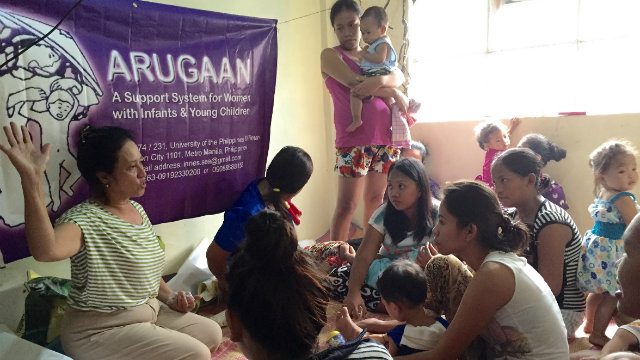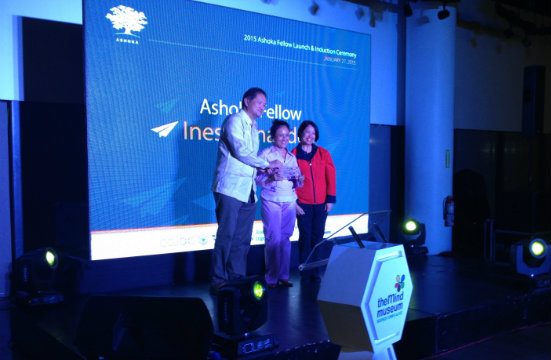SUMMARY
This is AI generated summarization, which may have errors. For context, always refer to the full article.

MANILA, Philippines – Ines Fernandez has only two kids yet a thousand others look up to her as their mother.
Like a good mom, ‘Nanay Ines’ – as she is fondly called – has been visiting rural communities to teach other moms tips for responsible parenthood. She would stay there for days, sometimes months, until her ‘daughters’ – who are also moms – learn by heart the indispensable lessons of motherhood. Like a mother’s love, everything is provided without condition or cost.
“We provide organized mother-to-mother support. So whatever they learn, they will share it,” Fernandez said with a proud smile, adding that there are thousands of women whom they have taught already.
She has been part of Arugaan, a mother-led movement promoting breastfeeding, responsible childcare, and the preparation of indigenous, nutritious baby foods to mothers in rural communities.
“Arugaan is a deeply rooted Filipino word. It means ‘nurture fully with lifetime commitment.’ That’s what we do. We commit ourselves to help moms, to be partners with them in their stage of pregnancy, birthing, breastfeeding, and indigenous food,” Fernandez said.
The women in Arugaan serve as mothers for a living.
Lost tradition
The organization started as a simple movement thirty years ago with 9 strong-willed mothers who realized that the feeding of the future generations no longer depended on the mothers’ hands but on commercial products being fed to many babies.
“It’s a global issue. Food is a global issue for as long as there are artificial foods, our problem stays. But even then, we overcome,” she added.
Breastfeeding and the preparation of indigenous foods, Nanay Ines said, are cheap and healthy traditions that have been forgotten by many. She wants to turn this around.
“These are free, but we devalue them and, at the same time, we also endanger the power of the women to nurture the next generation,” Nanay Ines added.
But the task comes with its own challenges.
Alternatives
In the Philippines, more than half the population relies on breastmilk substitutes.
According to a survey conducted by the Food and Nutrition Research Institute, commercially produced Cerelac has beat all other baby foods as the very first solid food Filipino kids receive. This is despite existing and cheaper native Filipino food alternatives like lugaw which could be mixed with kalabasa, malunggay, or even breastmilk.
“These are free, but we devalue them and, at the same time, we also endanger the power of the women to nurture the next generation”
– Ines Fernandez on breastfeeding and indigenous foods
Fernandez also noted that in many places where bottle feeding is practiced, malnutrition among kids is still prevalent, although she admits there are no supporting studies to verify if there is a direct correlation between the two.
“There is a large food depot being dislocated that is free and very nutritious,” she said in Filipino referring to breast-feeding and local alternative foods.
Overcoming consumerism
But breastfeeding and preparing of indigenous food do more than address a mother’s concern for her child.
According to studies, an average household spends P4,000 per month on formula milk, bottles and teats. That’s roughly P24,000 for 6 months that could have gone to the other needs of the infant. Cutting back on artificial foods could result in higher family savings. Converesely, it would potentially slash a big chunk from the babycare industry that is estimated to earn P42 billion a year.
“Sayang, this could have been channeled to education expense or to housing needs,” Fernandez said. The potential economic impact is most crucial in crisis areas where moms lack the money to buy food.
Resilient mothers
Fernandez said that mothers also need to consider what would happen during times of crisis, where “the only food that is not contaminated is breast milk.”
When Arugaan visited areas affected by typhoon Yolanda (Haiyan) in 2013, Fernandez observed that families grew tired of eating canned goods but did not know of other cheaper and healthier food alternatives.
So they taught more than 6,000 mothers how to prepare spaghetti cooked with ingredients taken from their backyard. They also taught them proper lactation massage so mothers could breastfeed their hungry babies. The results, Fernandez said, were overwhelming.
“For example in Zamboanga, we were able to train peer counselors tapos after five months, they said they are now collecting breast milk for sick babies. These peer counsellor mothers who are also recipient of 4Ps, decided to set up a milk bank for sick babies.”
Making waves
Fortunately, the group’s effort to make breastfeeding appealing is paying off.
Arugaan, together with other breastfeeding advocates and women’s groups, have pushed for the passage of three laws that empower mothers. Such as the “Expanded Breastfeeding Promotion Act,” aimed at providing incentives for government and private institutions following the Milk Code; and the Rooming-In and Breast-feeding Act of 1992, requiring private and government health facilities to adopt rooming-in and breast-feeding practices.

The United Nations Children’s Fund (UNICEF) reports that the Philippines is one of 37 countries in the whole world that fully implements the International Code of Marketing of Breast-milk Substitutes through its Milk Code.
On January 27, 2015, Ines Fernandez was also named an Ashoka felllow for her groundbreaking work helping mothers in rural and disaster-stricken areas.
Optimistic
Nanay Ines remains optimistic that there will come a time when the next generation will be nurtured fully by breast milk.
At 61 and way past her child-bearing years, Nanay Ines is determined to ‘give birth’ to many more mothers who will join her in advocating for breastfeeding and responsible childcare. – Rappler.com
Add a comment
How does this make you feel?
There are no comments yet. Add your comment to start the conversation.